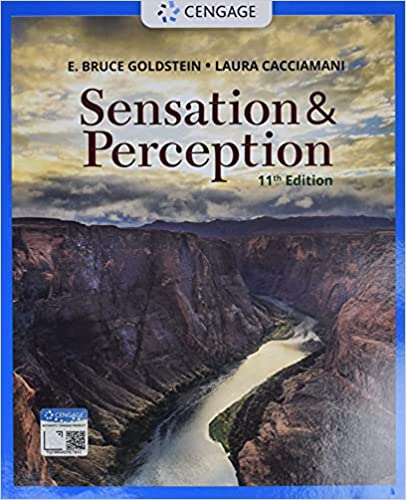Test Bank For Sensation and Perception, 11th Edition E. Bruce Goldstein
$20.00 & Free Shipping
ISBN-10: 035744647X
ISBN-13: 9780357446478
© 2022
Free shipping on orders over $50!
- Satisfaction Guaranteed
- No Hassle Refunds
- Secure Payments
Description
- Dedication
- About the Authors
- Brief Contents
- Contents
- Methods
- Demonstrations
- Preface
- Chapter 1: Learning Objectives
- Chapter 1: Introduction to Perception
- 1.1: Why Read This Book?
- 1.2: Why Is This Book Titled
- 1.3: The Perceptual Process
- 1.4: Studying the Perceptual Process
- 1.5: Measuring Perception
- Something to Consider: Why Is the Difference Between Physical and Perceptual Important?
- Chapter 2: Learning Objectives
- Chapter 2: Basic Principles of Sensory Physiology
- 2.1: Electrical Signals in Neurons
- 2.2: Sensory Coding: How Neurons Represent Information
- 2.3: Zooming Out: Representation in the Brain
- Something to Consider: The Mind-Body Problem
- Chapter 3: Learning Objectives
- Chapter 3: The Eye and Retina
- 3.1: Light, the Eye, and the Visual Receptors
- 3.2: Focusing Light Onto the Retina
- 3.3: Photoreceptor Processes
- 3.4: What Happens as Signals Travel Through the Retina
- Something to Consider: Early Events Are Powerful
- Chapter 4: Learning Objectives
- Chapter 4: The Visual Cortex and Beyond
- 4.1: From Retina to Visual Cortex
- 4.2: The Role of Feature Detectors in Perception
- 4.3: Spatial Organization in the Visual Cortex
- 4.4: Beyond the Visual Cortex
- 4.5: Higher-Level Neurons
- Something to Consider: “Flexible” Receptive Fields
- Chapter 5: Learning Objectives
- Chapter 5: Perceiving Objects and Scenes
- 5.1: Why Is It So Difficult to Design a Perceiving Machine?
- 5.2: Perceptual Organization
- 5.3: Recognition by Components
- 5.4: Perceiving Scenes and Objects in Scenes
- 5.5: Connecting Neural Activity and Object/Scene Perception
- Something to Consider: The Puzzle of Faces
- Chapter 6: Learning Objectives
- Chapter 6: Visual Attention
- 6.1: What Is Attention?
- 6.2: The Diversity of Attention Research
- 6.3: What Happens When We Scan a Scene by Moving Our Eyes?
- 6.4: Things That Influence Visual Scanning
- 6.5: The Benefits of Attention
- 6.6: The Physiology of Attention
- 6.7: What Happens When We Don’t Attend?
- 6.8: Distraction by Smartphones
- 6.9: Disorders of Attention: Spatial Neglect and Extinction
- Something to Consider: Focusing Attention by Meditating
- Chapter 7: Learning Objectives
- Chapter 7: Taking Action
- 7.1: The Ecological Approach to Perception
- 7.2: Staying on Course: Walking and Driving
- 7.3: Finding Your Way Through the Environment
- 7.4: Interacting With Objects: Reaching, Grasping, and Lifting
- 7.5: Observing Other People’s Actions
- 7.6: Action-Based Accounts of Perception
- Something to Consider: Prediction is Everywhere
- Chapter 8: Learning Objectives
- Chapter 8: Perceiving Motion
- 8.1: Functions of Motion Perception
- 8.2: Studying Motion Perception
- 8.3: The Ecological Approach to Motion Perception
- 8.4: The Corollary Discharge and Motion Perception
- 8.5: The Reichardt Detector
- 8.6: Single-Neuron Responses to Motion
- 8.7: Beyond Single-Neuron Responses to Motion
- 8.8: Motion and the Human Body
- 8.9: Motion Responses to Still Pictures
- Something to Consider: Motion, Motion, and More Motion
- Chapter 9: Learning Objectives
- Chapter 9: Perceiving Color
- 9.1: Functions of Color Perception
- 9.2: Color and Light
- 9.3: Perceptual Dimensions of Color
- 9.4: The Trichromacy of Color Vision
- 9.5: The Opponency of Color Vision
- 9.6: Color Areas in the Cortex
- 9.7: Color in the World: Beyond Wavelength
- Something to Consider: We Perceive Color From Colorless Wavelengths
- Chapter 10: Learning Objectives
- Chapter 10: Perceiving Depth and Size
- 10.1: Perceiving Depth
- 10.2: Oculomotor Cues
- 10.3: Monocular Cues
- 10.4: Binocular Depth Information
- 10.5: The Physiology of Binocular Depth Perception
- 10.6: Depth Information Across Species
- 10.7: Perceiving Size
- 10.8: Illusions of Depth and Size
- Something to Consider: The Changing Moon
- Chapter 11: Learning Objectives
- Chapter 11: Hearing
- 11.1: Physical Aspects of Sound
- 11.2: Perceptual Aspects of Sound
- 11.3: From Pressure Changes to Electrical Signals
- 11.4: How Frequency Is Represented in the Auditory Nerve
- 11.5: The Physiology of Pitch Perception: The Cochlea
- 11.6: The Physiology of Pitch Perception: The Brain
- 11.7: Hearing Loss
- Something to Consider: Explaining Sound to an 11-Year Old
- Chpater 12: Learning Objectives
- Chapter 12: Hearing in the Environment
- 12.1: Sound Source Localization
- 12.2: The Physiology of Auditory Localization
- 12.3: Hearing Inside Rooms
- 12.4: Auditory Scene Analysis
- Something to Consider: Interactions Between Hearing and Vision
- Chapter 13: Learning Objectives
- Chapter 13: Perceiving Music
- 13.1: What Is Music?
- 13.2: Does Music Have an Adaptive Function?
- 13.3: Outcomes of Music
- 13.4: Musical Timing
- 13.5: Hearing Melodies
- 13.6: Creating Emotions
- Something to Consider: Comparing Music and Language Mechanisms in the Brain
- 13.7: Coda: Music Is “Special”
- Chapter 14: Learning Objectives
- Chapter 14: Perceiving Speech
- 14.1: The Speech Stimulus
- 14.2: Variability of the Acoustic Signal
- 14.3: Some History: The Motor Theory of Speech Perception
- 14.4: Information for Speech Perception
- 14.5: Speech Perception in Difficult Circumstances
- 14.6: Speech Perception and the Brain
- Something to Consider: Cochlear Implants
- Chapter 15: Learning Objectives
- Chapter 15: The Cutaneous Senses
- 15.1: Overview of the Cutaneous System
- 15.2: Perceiving Details
- 15.3: Perceiving Vibration and Texture
- 15.4: Perceiving Objects
- 15.5: Social Touch
- 15.6: The Gate Control Model of Pain
- 15.7: Top-Down Processes
- 15.8: The Brain and Pain
- 15.9: Social Aspects of Pain
- Something to Consider: Plasticity and the Brain
- Chapter 16: Learning Objectives
- Chapter 16: The Chemical Senses
- 16.1: Some Properties of the Chemical Senses
- 16.2: Taste Quality
- 16.3: The Neural Code for Taste Quality
- 16.4: Individual Differences in Taste
- 16.5: The Importance of Olfaction
- 16.6: Olfactory Abilities
- 16.7: Analyzing Odorants: The Mucosa and Olfactory Bulb
- 16.8: Representing Odors in the Cortex
- 16.9: The Perception of Flavor
- Something to Consider: The Community of the Senses
- Appendix A: The Difference Threshold
- Appendix B: Magnitude Estimation and the Power Function
- Appendix C: The Signal Detection Approach
- Glossary
- References
- Name Index
- Subject Index




